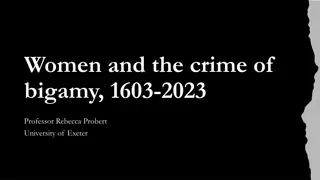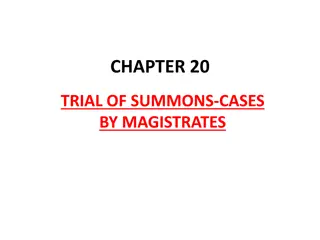
Evolution of Punishments: From Medieval Ages to Modern Era
Explore the evolution of punishments from the medieval period to the modern era, examining the changes, continuities, and significant turning points. Discover how punishments shifted from physical and public penalties to prisons and transportation, reflecting shifting societal values and goals of deterrence, retribution, and rehabilitation.
Download Presentation

Please find below an Image/Link to download the presentation.
The content on the website is provided AS IS for your information and personal use only. It may not be sold, licensed, or shared on other websites without obtaining consent from the author. If you encounter any issues during the download, it is possible that the publisher has removed the file from their server.
You are allowed to download the files provided on this website for personal or commercial use, subject to the condition that they are used lawfully. All files are the property of their respective owners.
The content on the website is provided AS IS for your information and personal use only. It may not be sold, licensed, or shared on other websites without obtaining consent from the author.
E N D
Presentation Transcript
Date: 22 April 2025 Title: Crime and punishment: punishments change and continuity and applying this to the exam. Aim: 1. To recognise the changes and continuities within punishments To have a discussion about the turning points in punishments 3. To apply this to exam questions. 2.
2. 1500-1700 (early modern England) Continuity: Many of the punishments from the medieval period continued to be used. Fines, stocks and pillory, corporal punishment, hanging Change and new punishments: Prisons: 1500s Used as a holding areas to hold people who were awaiting trial. 1566 Bridewell Prison: used to punish poor people who had broken the law (vagabonds) Inmates were made to do hard labour. Burning at the stake (1500s because of the changes to religion) Branding Vagabonds with a V because of the new laws against Vagabondage Capital punishment and the Bloody Code: During the 17th century, the number of crimes that carried the death penalty increased. There 50 capital crimes by 1688 (poaching etc.) Known as the Bloody Code. The intention was to create a strong deterrent. Even more crimes were made capital offences in the 18th century. Transportation to North America. This new form of punishment was introduced under James I (1603) They would be transported to North America, where they would do harsh labour for 14 years or 7 years for a lesser crime. Transportation were favoured by the authorities because: It was an effective deterrent. England did not have an effective prison system England wanted to establish permanent colonies in North America. Some started to suport rehabilitation. Criminals were taken away from bad influences, which may help them to reform. 50,000-80,000 people were transported to America. 1. Medieval period Anglo-Saxons: Wergild: Fines paid to the victim s family. Intended to reduce blood feuds. The fines were decided by social status. (prince killed = fine was 1500 shillings, yeoman farmer = fine was 100 shillings, serf killed = fine was 40 shillings). Capital punishment: death penalty (treason and arson) Corporal punishment: harm or pain = intended to act as a deterrent because people would watch how gruesome it was, also they would constantly be visible in the communities. (removing an eye, hand or foot). Stocks and the pillory: Public punishment. Outdoors in public, the public may also throw rotten fruit at them. Normans: Continuity: Continued to use physical punishments, fine and executions. Change: WERGILD ENDED and FINES WERE NOW PAID TO THE KING S OFFICIALS instead of to the victim. This shows a move towards centralisation. Change: An increase in crimes that were punishable by death or mutilation. Forest laws = poaching was punishable by death. Later middle ages: Continuity: Continue to use fines, corporal punishment and execution Change: A NEW PUNISHMENT WAS CREATED FOR HIGH TREASON THE MOST SERIOUS CRIME (plotting to betray or kill the King, because it was an act against God and the King because the King was chosen by God) = HUNG, DRAWN AND QUARTED. Main aims of punishment = 1) deter 2) retribution Main aims of punishment = 1) Deter 2) Retribution 3) Beginning of rehabilitation 4) Economic/practical Death penalty: Continuity: Still used By 1688 the number of crimes that were punishable by the death penalty had increased to 50 and by 1765, to 160. By 1810, this had increased again to 222 crimes. Change: During the early part of the 19th century the Bloody Code was increasingly question. Public executions were stopped in 1868. Executions STILL took place, but far away from the public view. (mainly because the crowds that watched them were drunk and disorderly, they saw it as fun rather than a deterrence, they saw the criminal as a hero and the authorities as evil, more crimes happened during public executions e.g. pick-pocketing.) Transportation: Change: Convicts begin to be sent to Australia rather than North America (because NA is no longer a colony in 1783). 160,000 people transported to Australia. Transportation to Australia ends in 1868. Why does transportation end: Some argued conditions on ships were inhumane. Australia started to be seen as a nice place to settle so was no longer a deterrent. Expensive. Some people wanted to use prisons instead. Prisons: Change: Before 18th century (previous time period) prison was rarely used as a punishment (remember they were used to hold people). 18th and 19th centuries, the use of imprisonment as a punishment grew, and it was seen as a suitable alternative to the Bloody Code and transportation. Why Prisons: Opportunity to change or rehabilitate. Could punish as well as deter Hard work would allow the criminal to pay society back. Protection for society. Prison reformers: John Howard and Elizabeth Fry Death penalty: Continuity: At the start of the 20th century (1900s) capital punishment was still used usually for the crime of murder. Early 1950s, around 15 people a year were executed. Change: Homicide Act of 1957 restricted the death penalty to the most serious cases of murder. 1965 the Murder Act suspended the death penalty for murder for five years this decision was made permanent in 1969. By 1965 the death penalty was abolished for most crimes. By 1998 the death penalty was ENDED FOR ALL CRIMES IN 1998. Why Home secretary at the time, Roy Jenkins he had strong views about ending the death penalty very influential. Case studies such as, Derek Bentley, Timothy Evans and Ruth Elis started to change attitudes towards the death penalty for murder. 4. 1900s-present day 3. 1700s-1900s Main aims of punishment = 1) Rehabilitation 2) Deter 3) Retribution 4) Protection for society (new ideas about humanity, key individuals) Children: Change: Children started to be shown more tolerance. People started to realise that children do not have the same understanding as adults, therefore they should not be punished the same. Children s Act 1908: No longer punished by death if under 16. Young Person s Act 1933: Age limit raised to 16. Infanticide Act, 1922: Women would not be punishable by death if they killed their child shortly after its birth (showed an understanding of a woman s mental state after birth). Main aims of punishment = 1) More attitudes that capital punishment is inhumane. 2) More focused on reform and rehabilitation. Prisons Change: Prisons use increased heavily. Different types of prisons started to emerge Borstals 1900s 1982 Youth borstals replaced with youth custody centres. 1948: Criminal Justice Act introduced 1963 Children and Young Persons Acts offenders. (care orders, supervision by probation officers, social workers, instead of prison sentences. more about probation and rehabilitation. focused on the importance of caring for and protecting young
What changed and what stayed the same? Task: Have a look at your punishments sheet and sum up the time period s punishments with one word. (e.g. deter, harsh etc.) Then, discuss in your pairs 1. What are the main aims of punishment. 2. When do the aims begin to change. 3. Why do they begin to change. 4. At which points do the biggest changes happen what factors cause this.
How can we apply this to the exam? In the period 1500-1700 the main aim of changes to punishments was retribution. 16 marks The end of capital punishment was a turning point in punishments How far do you agree? 16 marks Explain why transportation was used as a punishment in the period 1600-1850? 12 marks. Explain why there were changes in the prison system in the period 1700-1900s. 12 marks Explain why Anglo-Saxons used corporal punishments to deal with criminals. 12 marks Explain one way in which treatment of witchcraft in the period 1500-1750 was similar to the treatment of conscientious objection in the 20th century. 4 marks. Explain one way in which punishments in the years 1500-1700 were different to punishments in the Medieval period . 4 marks. Explain one way in which punishments were similar in the Anglo-Saxon period and the later medieval period. 4 marks.
The end of capital punishment was a turning point in punishments How far do you agree? 16 marks Introduction judgement PEEL (both sides) x3 Conclusion turning point, because these changes in attitudes started to occur as far back as the 1700-1900s. Point: On the other hand the end of capital punishment was not a huge Point: The end of capital punishment in 1998 was a huge change because it had been used throughout since the Anglo-Saxon period, and its end marked a shift in attitudes to punishment. Evidence/explanation: Reform/rehabilitate More prisons used, transportation. Evidence/explanation: The end of capital punishment allowed for other punishments to be used more such as prisons, community service, borstals, probation and fines. Therefore the end of capital punishment marked a move towards rehabilitation rather than retribution and deterrence. One reason for this was due to case studies such as Derek Bentley and Ruth Ellis, in which capital punishment was seen as injust.






















